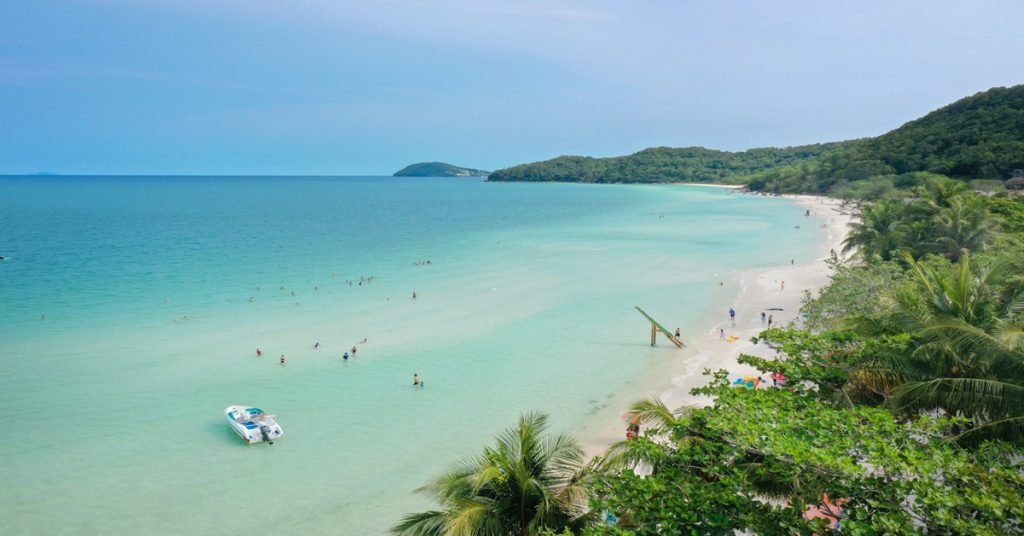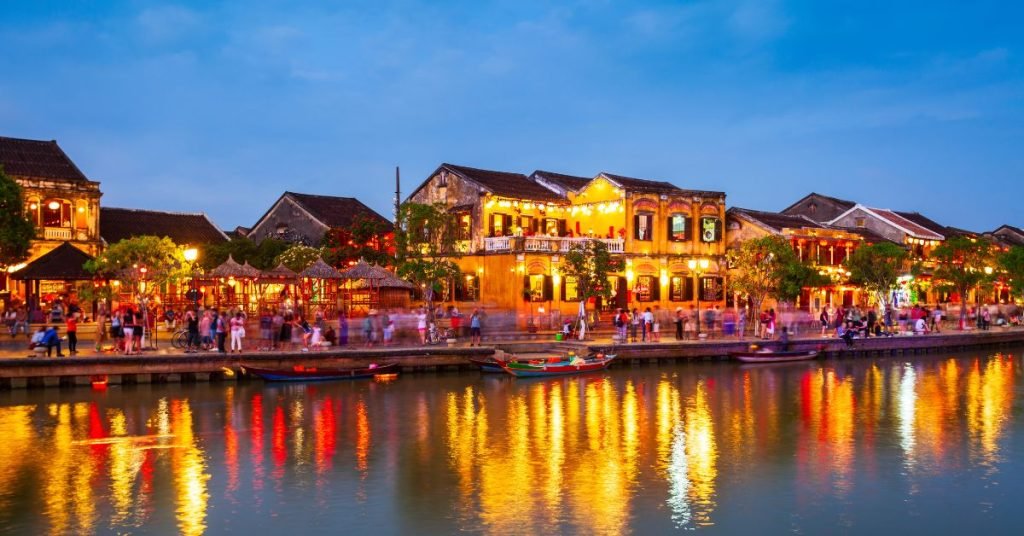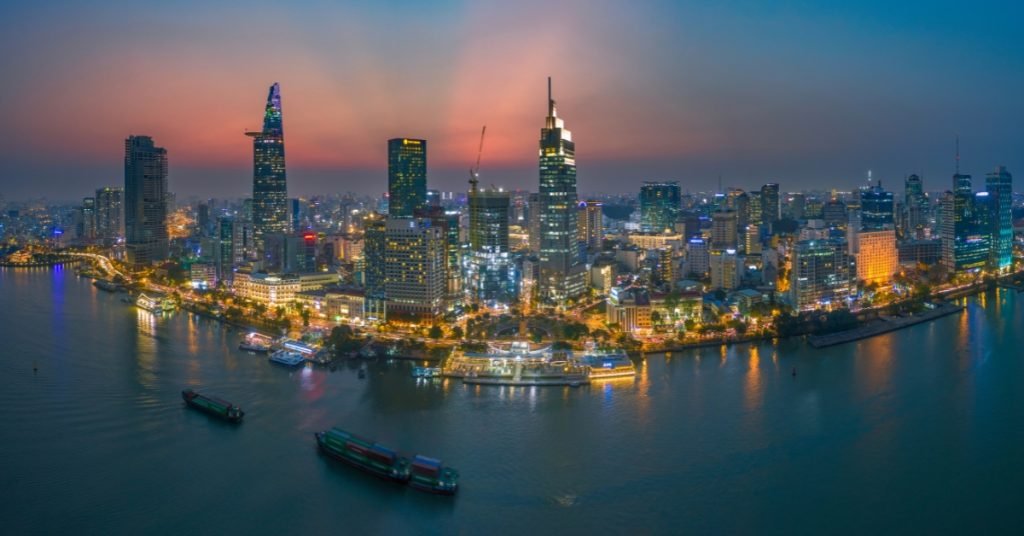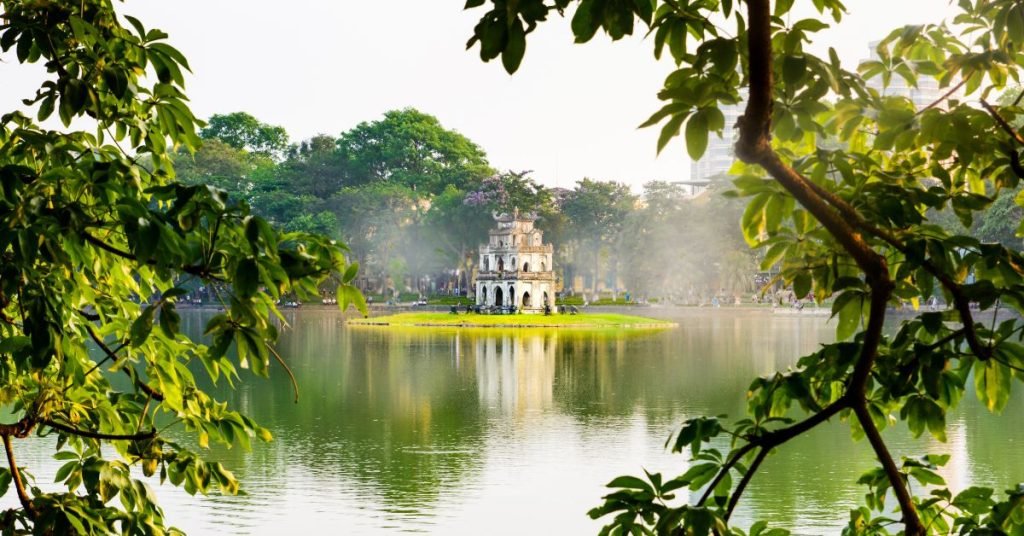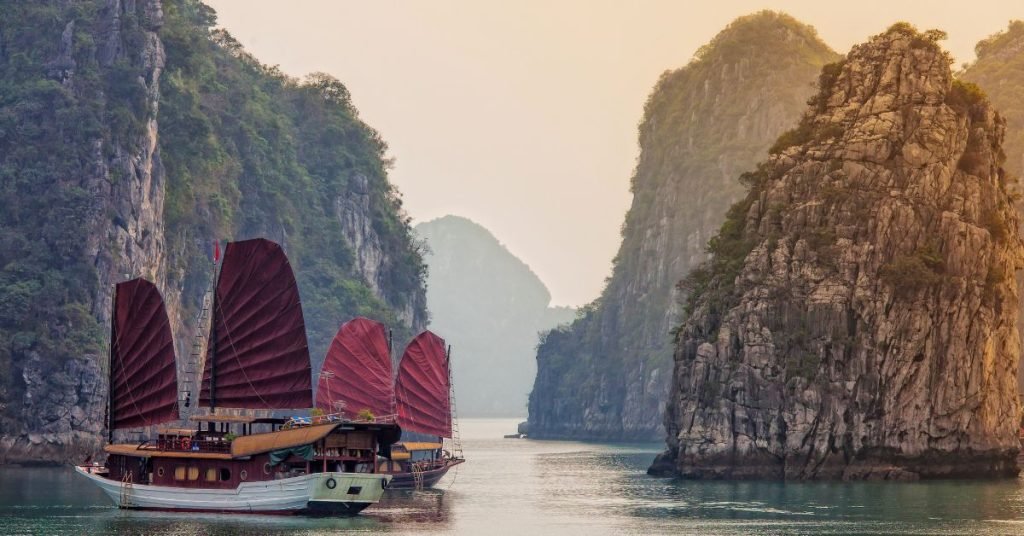Welcome to the Vietnam Travel Guide website. Here, you will find a Google Maps interface with pre-marked popular tourist spots(1) along with real reviews from Google Maps. Helper chatbot(2) are multilingual. Audio files(3) detailing various locations, historical structures.
North to South Highlights
Tap ![]() for list or categories,
for list or categories, ![]() for place detail.
for place detail.
Discover the stunning landscapes from Ha Giang to Phu Quoc, experiencing the diverse culture and rich heritage of ethnic minorities, and enjoying the majestic mountainous vistas and the beautiful coastlines.
North to South highlights
Ha Giang: Discover the rugged landscapes and cultural richness of Vietnam’s northernmost province. Famous for its terraced fields and ethnic diversity, Ha Giang offers a glimpse into traditional lifestyles.
Sa Pa: Nestled in the northern mountains, Sapa is famous for its terraced rice paddies and the highest peak in Vietnam, Mount Fansipan.
Moc Chau: Immerse yourself in the lush greenery of Mộc Châu Plateau, an agricultural marvel dotted with blooming flower fields, tea plantations, and dairy farms.
Dien Bien: Surrounded by steep mountains, this tranquil town offers insights into wartime history and is home to various ethnic minorities, each with their own unique traditions.
Ha Noi: The capital city is known for its centuries-old architecture and a rich culture with Southeast Asian, Chinese and French influences. Explore the chaotic charm of the Old Quarter and the tranquility of Hoan Kiem Lake.
Ha Long : Marvel at the emerald waters dotted with limestone islands. This UNESCO World Heritage site is best explored by boat.
Ninh Binh: Offers a taste of ancient Vietnam with its historical landscapes, including the Trang An Scenic Landscape Complex and the ancient capital of Hoa Lu.
Quang Binh: boasts stunning natural landscapes including the renowned Phong Nha cave system and pristine coastal beaches. It’s an ideal destination for adventurers and beach lovers alike.
Hue: This ancient capital houses the remnants of the Imperial City, a vast complex of palaces, temples, walls, gates, a library and the Forbidden Purple City.
Da Nang: A vibrant city known for its sandy beaches and history as a French colonial port. The Marble Mountains are a major highlight.
Hoi An: Walk through the charming Ancient Town, a well-preserved example of a Southeast Asian trading port dating from the 15th to the 19th century.
Nha Trang: Enjoy this seaside resort city known for its beaches, diving sites, and vibrant nightlife.
Da Lat: The “City of Eternal Spring” is loved for its temperate weather, scenic beauty and remnants of French colonial architecture.
Binh Thuan: Known for its sunny beaches and coastal roads, with Mui Ne being a highlight for its unique terrain and private beaches.
Ho Chi Minh city: The bustling southern city offers a mix of historic French architecture and modern skyscrapers, along with bustling markets and vibrant street food culture.
Tien Giang: Venture into the heart of the Mekong Delta with Tiền Giang’s maze of rivers, lush orchards, and vibrant floating markets.
Can Tho: Known as the “Rice Bowl” of Vietnam, it’s famous for its floating markets, delicious food, and the Mekong Delta’s vibrant lifestyle.
Ca Mau: At Vietnam’s southern tip, Cà Mau beckons as a gateway to diverse ecosystems, from dense mangroves to unique aquatic life in its national park.
Phu Quoc Island: An island paradise off the southern coast of Vietnam, known for its white sandy beaches, crystal-clear waters, and luxury resorts.
Top Destinations
Phu Quoc Island
The Island Paradise Phú Quốc, the largest island in Vietnam, located in the Gulf of…
Hoi An
The Ancient Town Hội An, with its well-preserved old town and quaint charm, radiates a…
Da Nang
The Modern Coastal City Đà Nẵng, with its unique mix of bustling streets, pristine beaches,…
Ho Chi Minh city
The Bustling Metropolis Thành Phố Hồ Chí Minh, formerly known as Saigon, is the economic…
Ha Noi
The Capital Hanoi, Vietnam’s capital, is a fascinating blend of East and West, combining traditional…
Ha Long
Vietnam’s Coastal Elegance A jewel in the crown of Vietnam’s natural attractions, Ha Long Bay…
Activities, Experiences
From the historical charm of Hoi An Ancient Town to the underwater splendor of Phong Nha caves, and from the serene beaches of Da Nang and Nha Trang to the adventurous Ha Giang Loop, Vietnam offers a tapestry of experiences. Discover Phu Quoc Island’s vibrant mix of beachfront leisure, entertainment, and cultural events for a comprehensive exploration of the nation’s beauty.
Activities, Experiences
Strolling through Hoi An Ancient Town: The blend of historical influences makes Hoi An a picturesque town that’s ideal for photography and cultural exploration, especially in the early hours before the tourist rush.
Cave Explorations in Phong Nha: The Phong Nha caves are an essential part of the Vietnam sightseeing experience, with Hang Son Doong being a highlight due to its immense size and unique beauty. Visitors can tour many of these caves by boat and take guided tours to fully appreciate their grandeur.
Beach Relaxation: Stretching along the length of the country, Vietnam’s extensive coastline boasts stunning beaches in cities like Da Nang and Nha Trang, along with others such as My Khe, Lang Co, An Bang, Cua Dai, Long Beach, Rach Vem, and Khem Beach. Additionally, the serene Con Dao Islands provide pristine beach experiences, encapsulating the beauty of Vietnam’s diverse coastal landscapes.
The Ha Giang Loop is a quintessential motorbike adventure, offering a glimpse into Vietnam’s rugged terrain and rich cultural tapestry through a series of breathtaking mountain passes and valleys.
Phu Quoc Island Activities: In addition to the beautiful beachfront resorts, there are also Sunset Town and Grand World, visitors can enjoy a dynamic mix of entertainment, including dazzling fireworks, traditional Vietnamese art shows, a safari park, a water park, and a theme park. This vibrant destination combines cultural richness with thrilling recreational activities, making it a must-visit for an all-encompassing entertainment experience on the island.
The Imperial City of Hue: Hue is renowned for its historical significance as the seat of the Nguyen Dynasty emperors. Touring the Imperial City gives a glimpse into the country’s regal past.
Underrated Da Nang: This city is emerging as a vibrant urban center with its scenic bridges, mountainous backdrops, and stretches of beautiful beaches.
Trekking in Sapa: This northern region is celebrated for its breathtaking rice terraces and ethnic village tours, providing a genuine immersion into the local hill-tribe cultures.
Mekong Delta Cruises: The Mekong Delta offers a fascinating cultural experience where the Mekong River meets the sea. Here, visitors can embark on cruises or boat rides, experience the floating markets, and observe the lively trade activities.
Sandboarding in Mui Ne: The Red and White Sand Dunes near Mui Ne provide a perfect setting for sandboarding, a must-try for adventure enthusiasts.
Exploring My Son Ruins: The My Son Hindu Sanctuary provides a look into the ancient Champa civilization and is an important archaeological site, giving insights into historical religious practices and architecture.
Cooking Classes and Food Tours: Engaging in cooking classes and food tours, especially in cities like Hanoi, can provide deep insights into the Vietnamese culinary scene. These experiences often include market visits and cooking local dishes under expert guidance.
Stay, Dine & Transportation
Vietnam’s vibrant culinary scene offers everything from budget-friendly street eats to exquisite fine dining, while accommodation options range from cozy guesthouses to opulent hotels. Navigate with ease using various transportation methods tailored to every traveler’s need.
Stay, Dine & Transportation
Best travel periods
- Northern Vietnam (Hanoi, Halong Bay, Ninh Binh): The best times are spring (March to April) and autumn (September to November) with mild temperatures and dry weather.
- Central Vietnam (Hue, Hoi An, Da Nang): Ideal from January to August, before the rainy season begins.
- Southern Vietnam (Ho Chi Minh City, Nha Trang, Mekong Delta): Visit during the dry season, December to April, for less humidity and minimal rainfall.
The destinations listed above are among the most visited by tourists
In Vietnam, daily expenses for dining and accommodation can vary widely depending on the service type and region. Here’s a general estimate:
For dining:
- A simple meal at a local eatery or street food ranges from approximately 30,000 to 50,000 VND (equivalent to 1.3 to 2.2 USD).
- A meal at a high-end restaurant may start from 200,000 VND (around 8.5 USD and up).
For accommodation:
- Budget guesthouses or hotels cost between 200,000 to 500,000 VND per night (approximately 8.5 to 21.5 USD)
- Luxury resorts or high-end hotels start at 1,000,000 VND per night (from 43 USD).
For in-city transportation:
- Services like Grab and taxis from companies like Vinasun and Mai Linh charge about 10,000 to 15,000 VND per kilometer (approximately 0.43 to 0.65 USD).
- City bus fares range from 6,000 to 10,000 VND (around 0.26 to 0.43 USD).
Estimated daily costs in Vietnam for meals, accommodation, and local transportation might range from approximately 30 USD to around 130 USD, reflecting a day’s expenses for various comforts and conveniences.
Intercity Transportation in Vietnam
For long-distance travel between provinces in Vietnam, passengers can opt for reputable bus companies such as Vexere, Phuong Trang, which offer affordable and reliable services. The cost for a bus ticket can vary widely depending on the distance and type of service (standard or VIP), but on average, one might expect to pay from 100,000 VND to 300,000 VND (approximately 4 to 13 USD) for a trip. For enhanced comfort on long-distance journeys, travelers can choose the “Luxury Sleeper Bus” a premium option with larger beds and amenities, costing around 400,000 VND (approximately 17 USD). Rail travel is also available via dsvn.vn, with fares from 150,000 VND to 1,500,000 VND (~6-64 USD), offering a scenic route across Vietnam.
Air travel is also a convenient option for intercity transportation. Domestic flights in Vietnam are operated by several airlines, including Vietnam Airlines, VietJet Air, Viet Travel and Bamboo Airways. The price for a one-way domestic flight can range from 00,000 VND to 2,000,000 VND (approximately 40 to 86 USD), depending on the time of booking, the route, and the airline chosen. Early bookings and promotions may offer lower fares.
When planning intercity trips in Vietnam, it’s recommended to compare different modes of transportation for the best combination of price, comfort, and travel time.
Communication & Payments
About reliable communication and payment options in Vietnam to ensure a smooth and secure travel experience
Communication & Payments
Language: Vietnamese is the official language. English proficiency is growing, particularly among younger generations and in tourist areas, so visitors can usually get by with English in major cities and tourist destinations. Learning a few basic Vietnamese phrases is appreciated and can enhance your travel experience. For the latest travel advisories and updates that may affect your journey, you should consult with your hotel’s receptionist or concierge service. If you encounter any language barriers, our chatbot helper can serve as an interpreter. It understands multiple languages and natural language, and has been trained to provide guidance on travel-related issues in Vietnam, ensuring you receive essential information for a safe and well-informed stay.
Currency and Payments: The official currency is the Vietnamese dong (VND). Approximate exchange rate: 1 USD = 26,000 VND, While larger establishments may accept credit cards, cash is essential for local markets, street food vendors, and smaller shops. ATMs are widely available in cities, but it’s wise to carry sufficient cash when traveling to more rural areas.
Scams
Common Travel Scams in Vietnam and How to Avoid Them
Travel Scams and how to avoid them
- Money Switching Scam: Avoid getting short-changed by taxi or motorbike drivers who may switch large bills for smaller denominations. Always try to use small bills or exact change.
- Overcharging by Street Vendors: In tourist-heavy areas like markets, some vendors might inflate prices significantly. Establish prices before purchasing and check typical costs with locals if possible).
- Pickpocketing and Bag Snatching: Common in busy streets and markets. Be extra vigilant, use anti-theft bags, and avoid displaying valuables.
- Fake Tour Operators and Tickets: Scammers often pose as legitimate agents online. Book tours and tickets through reputable sources and double-check operator reviews.
- Motorbike Rental Scams: Inspect rental motorbikes carefully and document any existing damage to avoid being charged for it later. Use reputable rental companies.
- Taxi Scams: Use metered taxis or verified ride-hailing apps like Grab to avoid being overcharged. If a taxi refuses to use the meter, it’s better to find another one.
- Street Vendor and Crowded Market Scams: Be wary of vendors who may try to draw your attention with unusual or “free” offers, as this can be a prelude to demanding payment for unsolicited services or goods. Always be cautious and polite but firm in declining offers that seem suspicious or too good to be true.
Traveler Support & Safety
About the comprehensive support and safety measures in place for travelers in Vietnam, ensuring a secure and enjoyable experience.
Traveler Support & Safety
For tourists needing assistance or emergency support across various destinations in Vietnam, it’s important to be equipped with the following general contact information:
- Police: 113
- Fire Department: 114
- Ambulance Service: 115
- Emergency Rescue: 112
These emergency services are available nationwide and should be contacted in the event of criminal activities, medical emergencies, fire incidents, or urgent rescue needs. However, it’s important to note that there may be delays, and operators might not always be fluent in English.
The hospitality of the locals in Vietnam is a great asset, and they are often willing to help tourists navigate their way around or in times of need. For non-urgent matters, including travel advice and support, tourists are encouraged to contact their home country’s embassy or consulate in Vietnam, where support is often available in multiple languages.
Many embassies provide emergency contact numbers for their citizens traveling abroad. Local tour agencies, hotel staff, and information centers can also assist with various services, including directions, recommendations, and support during your stay.
It’s highly recommended for travelers to have comprehensive travel insurance with medical coverage. This not only provides peace of mind but can be critical in covering treatment costs and offering additional support and resources in case of a medical emergency. Always ensure your insurance policy is valid and covers your activities while in Vietnam.
Visa Policy and Border
Visa and Border Entry Policies: What Travelers Need to Know
Visa and Border Entry Policies
Citizens from various countries can enter Vietnam visa-free: Chile and Panama (up to 90 days for non-remunerated activities); Cambodia, Indonesia, Kyrgyzstan, Laos, Malaysia, Singapore, Thailand (up to 30 days); Philippines (up to 21 days); Brunei, Myanmar (up to 14 days for visiting); Belarus (up to 45 days); Denmark, Finland, France, Germany, Italy, Japan, Norway, Russia, South Korea, Spain, Sweden, UK (up to 45 days, except BNO passport holders); Kazakhstan (up to 30 days, not exceeding 90 days within 180 days). Conditions require a valid passport with 2 blank pages and no paid activities. For longer stays, apply for a visa extension officially. Check updates before travel and enjoy Vietnam!
- Airports: There are 13 international airports eligible for e-visa entry, including Noi Bai in Hanoi, Tan Son Nhat in Ho Chi Minh City, Cam Ranh in Khanh Hoa, and others.
- Land Border Gates: There are 16 land border gates where e-visa holders can enter, such as Tay Trang (Dien Bien), Mong Cai (Quang Ninh), Moc Bai (Tay Ninh), Ha Tien (Kien Giang), and others.
- Sea Ports: Vietnam also has 13 sea border gates that accept e-visa holders, including Hon Gai and Cam Pha in Quang Ninh, Hai Phong, and others.
Applicants can simply apply online for their tourist e-visa, receive a code by email, and print their visa or access it via the official website of the Vietnam Immigration Department.
Upcoming Events
April Events in VIetnam
April Events in VIetnam: Celebrating National Unity with Dazzling Displays
April Events in Vietnam: Celebrating National Unity with Dazzling Displays
Vietnam is set to celebrate Reunification Day this April with an array of vibrant events. Spectacular drone light shows and fireworks are on the agenda, with one highlight being the Thầy Pagoda Festival, where 200 drones will illuminate the skies above Hanoi for the first time. This drone performance will feature the map of Quốc Oai District along with symbols representing the cultural heritage of the region.
In Ho Chi Minh City, fireworks will light up 16 different locations on April 30th to commemorate the 49th anniversary of National Reunification. Additionally, visitors can witness Southeast Asia’s largest drone light show by Ho Tay (West Lake) in Hanoi, set to break records on the eve of the festivities.
The Ha Long Carnival 2024, aligning with National Reunification Day on April 30th and May Day on May 1st, promises another thrilling drone light show, adding to the national spirit of celebration. These shows, paired with traditional art performances, culinary events, and the promotion of cultural and craft products, make April a month full of engaging experiences for both locals and tourists alike.
- Navigate hand-picked with our custom Google My Map, thoughtfully enhanced with insights from both user reviews and the proprietors themselves for a truly authentic travel experience. Tap
 for list, categories ↩︎
for list, categories ↩︎ - With a helper chatbot, you can input your language and the chatbot will communicate with you in that language. For a talk bot (we are working on it), please announce in your language that you want to translate to Vietnamese. ↩︎
- Each audio file, if available, will be included in the article introducing that particular location. ↩︎

